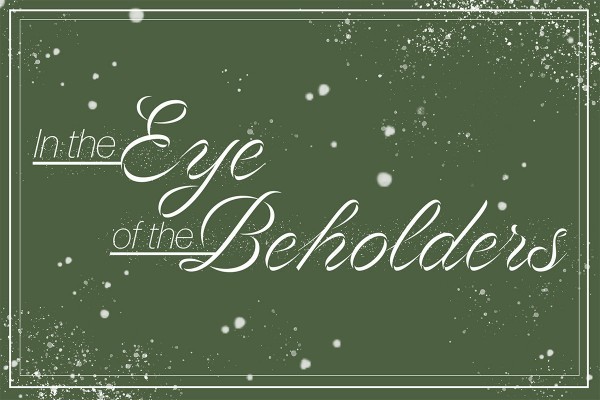This column is supported by DPAG, but they have no influence on the reviews
Every week, we send two writers to an art exhibit in Ōtepoti Dunedin. One of them will choose a specific piece, and describe it to the other without them looking. They’ll try to figure out what the piece actually is before diving into their thoughts on the entire exhibition. You can’t ascribe any one meaning to any one piece of art, so this functions a bit like a game of artistic telephone. Let’s dive in.
This Week: Hurahia ana kā Whetū – Unveiling the Stars
A new look at what we look at
Esmond: I’m looking at an artwork that hangs. It’s very tall and thin, made of a material that is associated with florists. There is a repeating motif that refers to navigation traditions, and the work relates to cultural practices taught to this artist by their grandmother. This work challenges the divisions between art and craft.
Maddie: Ok, the florist hint is a giveaway! Is it the weaving made out of florist’s ribbon that looks like a huge bridal veil dotted with stars, by Ani O’Neill?
The answer: Correct! We’re looking at Ani O’Neill’s 1993 piece Kua Marino te Tai (The Sea is Calm), a work made of woven florist’s ribbon. It’s part of Dunedin Public Art Gallery’s Hurahia ana kā Whetū exhibition, and one that perfectly captures the overarching theme of navigating the gallery’s future by the “star” works in the collection.
After a short hiatus, we’re back at the DPAG! We’re checking out Hurahia ana kā Whetū – Unveiling the Stars; a collaboration between the DPAG staff and Paemanu, a group of Kāi Tahu contemporary visual artists, curated largely from the gallery’s permanent collection. It’s a star-studded new look for the DPAG; a glow up, if you will.
The exhibition is housed within the large ground floor gallery spaces. This is a space that is reserved for the display of works of the DPAG collection, which holds Aotearoa New Zealand art from as far back as the 1860s, as well as a range of significant historical and contemporary works. In Hurahia ana kā Whetū the collection has been re-analysed by Paemanu and curated through a Kāi Tahu lens.
A prime example of this is the entranceway of the gallery, which is arranged in an artistic representation of a marae. Cath Brown’s Karanga Ngāi Tahu II (2002), calls out to visitors, inviting them into the space. The walls of which have been transformed into the art installation Kua hoki mai ngā Karae by Ross Hemera. Motifs inspired by the rock art of ancient Māori are drawn directly onto the walls with traditional pigments. Turning a corner, the walls are flanked by Michael Parekowhai’s The Bosom of Abraham (1999). These fluorescent lights, screen printed with kowhaiwhai patterns, act as the interior supporting posts and panels of the marae. Finally, a series of watercolours by Frances Hodgkins hang on the back wall as portraits of tūpuna. While the identities of the wāhine depicted in these paintings are unknown or lost, they sit in a position of power and love, reconnecting them to their iwi.
We noticed that works are displayed in interesting relations to each other. For instance, Shona Rapira Davies’ Prototype for the Poles that Hold up the Sky (1991) is a sculpture that depicts Tāne in a handstand, ready to push and separate Rangi and Papa. Looking through Tāne’s legs we can spot his domain: the forest. Hanging on the opposite wall is I thought I heard you crying in the forest (2020), a playful acrylic painting by Ayesha Green that depicts a range of flora found in Aotearoa New Zealand. It can be fun to discover these connections between the works, or to forge your own.
Something funky and novel, which represents the exhibition’s overall dedication to revitalising and democratising the art institution, are the extended labels. Where art labels are often filled with jargon or obscure, vague symbolism, probably confusing the reader more — and further gatekeeping the art world while they’re at it- these labels are written by members of the public, in response to works that excited them. These responses take different approaches, some analytical, but many personal or poetic too. Reading them really makes you see each piece in a new light, and you may even spy a familiar name or two; see if you can spot Esmond’s one!
This exhibition may strike the viewer at first as a mish-mash, hodgepodge collection of works from different eras, mediums and cultures, but it is this juxtaposition that reminds us that we are looking. That exhibitions are never arbitrary, but a conscious cultivation of values. Hurahia ana kā Whetū – Unveiling the Stars offers a much-needed Kāi Tahu perspective, reckoning with the past in order to navigate the future.
Kia whakatōmuri te haere whakamua // ‘I walk backwards into the future with my eyes fixed on my past’.
Recommended song for your visit: Not Only I by Courtney Barnett and Marlon Williams.



